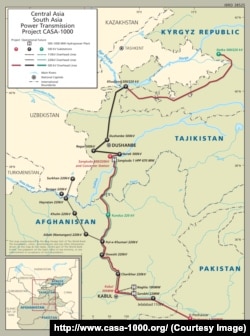The groundbreaking ceremony for the Central Asia-South Asia electricity transmission project, known as CASA-1000, is scheduled for May 12 in the Tajik capital, Dushanbe.
The leaders of Afghanistan, Kyrgyzstan, and Pakistan are coming to join Tajik President Emomali Rahmon for the event.
Afghan President Ashraf Ghani and Pakistani Prime Minister Nawaz Sharif were just in Central Asia in December, in Turkmenistan, for the “inauguration” of the Turkmenistan-Afghanistan-Pakistan-India (TAPI) pipeline.
The two projects would be a significant financial benefit to exporters Kyrgyzstan, Tajikistan, and Turkmenistan and provide a much-needed boost to the power supplies in Afghanistan, Pakistan, and India.
However, despite governmental and popular support in these countries for the projects, TAPI and CASA-1000 face significant obstacles and, in the end, it's possible neither will be realized.
To look at the two projects, what they mean for the region, and their chances for success, RFE/RL’s Turkmen Service, known locally as Azatlyk, conducted a Majlis, a panel discussion, to review the aims and possibilities of TAPI and CASA-1000.
Azatlyk Director Muhammad Tahir moderated the talk. From Glasgow, Dr. Luca Anceschi, professor of Central Asian studies at the University of Glasgow and one of the leading authorities on the TAPI project, participated. From New York, Casey Michel, author of many articles about Central Asia, including the recent report published in The Diplomat magazine -- CASA-1000 Groundbreaking Planned for May -- joined the discussion. In the studio in Prague we had Abubakr Siddique, author of the acclaimed book, The Pashtun Question, and also chief editor of RFE/RL’s Gandhara website, which is dedicated to Afghan and Pakistani affairs. I came up with a few comments also.
The CASA-1000 involves building a 1,222-kilometer power transmission line to carry some 1,300 MW of electricity from hydropower plants in Kyrgyzstan and Tajikistan into Afghanistan (300 MW) and on to Peshawar in Pakistan (1,000 MW). TAPI is supposed to bring some 33 billion cubic meters of gas annually along a pipeline some 1,735 kilometers long to Afghanistan, Pakistan, and India.
Speaking about what CASA-1000 would mean for the importers, Siddique recalled, “We have seen in the past few years that Pakistan has really suffered because of chronic electricity shortages.” The result of that, Siddique said, is “a lot of industries closed, a lot of rioting...there were just [recently] protests in Peshawar and other cities because of power cuts.”
Siddique said besides bringing needed electricity to Afghanistan, CASA-1000 is “very important because it establishes Afghanistan’s status as a main transit country between Central Asia and South Asia.”
TAPI would help Afghanistan cement a role as a transit country. But it is the instability in Afghanistan that is often given as the primary reason neither TAPI nor CASA-1000 are possible. The panel discussed growing instability in Afghanistan in the areas along the two projects’ routes.
LISTEN TO THE PODCAST
But there are other problems, further upstream.
Financing, in the case of CASA-1000, is not an issue. Michel explained the project has "finances from Washington, London, and the World Bank" and at a cost of “a little over $1 billion right now, it’s not nearly as expensive as TAPI is.”
TAPI does cost more, as Anceschi said. “It’s going to be a very expensive proposition, talking about $10 billion, [and] we know that there is not a commercial champion coming from the Western world.”
No major financial organization or any individual country has shown an interest in providing the large funding needed for TAPI, or for operating the project.
In the absence of such a partner, Anceschi noted, “The commercial champion, if you want, the consortium leader, is Turkmengaz, which does not have either the money or the expertise to run this program."
Turkmengaz has pledged to fund 85 percent of TAPI and operate the project, despite the fact it is doubtful Turkmengaz has that much money and the company has no experience managing a multinational project.
Evidence of a lack of funding is already becoming clear. Since the end of April, Turkmen President Gurbanguly Berdymukhammedov made proposals to Qatar and Saudi Arabia to invest in TAPI, seeming to disregard the fact both are competitors for the same energy markets.
Since the launch of TAPI in December 2015 the Turkmen state media (the only media in Turkmenistan) has reported on progress in laying pipeline on Turkmenistan’s territory. But there is no evidence any work has been done and even these state media reports have failed to include images of construction work.
“I haven’t spoken or heard from anyone who can confirm that he or she actually saw the work progressing,” Anceschi said, adding that considering the low prices for gas on world markets, the window of profitability for TAPI seems to be closing rapidly.
CASA-1000 has the necessary money behind it to see the project realized. But Michel pointed out that as concerns the energy source, “We know where it’s coming from for TAPI, as pertains to CASA-1000, that’s one of the big questions.”
Hydropower plants (HPP) in Kyrgyzstan and Tajikistan will supply the electricity for CASA-1000. But there has been less precipitation in Kyrgyzstan in recent years and reservoirs there, particularly the massive Toktogul reservoir, are low on water. In 2013, Kyrgyzstan exported electricity to Kazakhstan. Kyrgyzstan is now importing electricity from Kazakhstan and also from Tajikistan. Tajikistan is exporting electricity to Kyrgyzstan and Afghanistan in the summer.
In the winter, Tajikistan suffers from power shortages, even severe shortages when the winters are especially cold.
Tajikistan’s Nurek HPP will provide electricity to CASA-1000. But Nurek started operations in 1972 and is now in need of repair, which the cash-strapped Tajik government is unlikely to able to afford.
Two of Tajikistan’s newest HPPs are foreign-owned. Sangtuda-1 is also a contributor to the CASA-1000 transmission line. The Russian government and Russian companies own more than 70 percent of Sangtuda-1. When Russia funded and helped construct it, the agreement stipulated Russian ownership until Russian loans and expenses for Sangtuda-1 were repaid. Sangtuda-1 has never shown a profit due to the chronic debt of Tajik state power company Barki Tojik, which itself is short of money due to unpaid bills, mainly of state or state-sponsored organizations.*
So CASA-1000 has the financial backing, but it’s uncertain the necessary power source is there. TAPI has the power source but its funding is unclear.
The discussion ranged also to the potential role of Iran in this South Asian energy equation, insurgencies along the project routes, the individual policies of governments involved, and how these policies could complicate or derail entirely the projects and even further into other areas.
*Iran is the majority shareholder in Sangtuda-2, completed under similar repayment terms as Sangtuda-1. Sangtuda-2 is also in debt.


